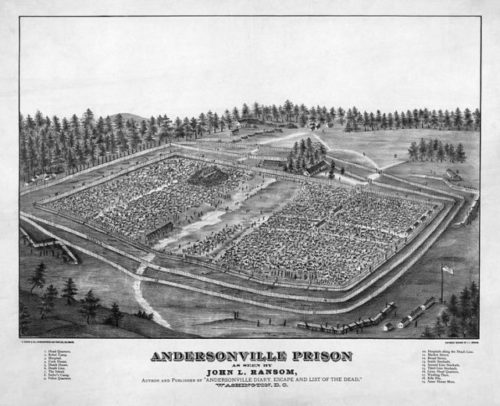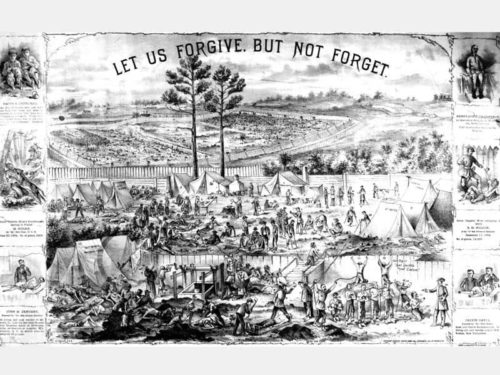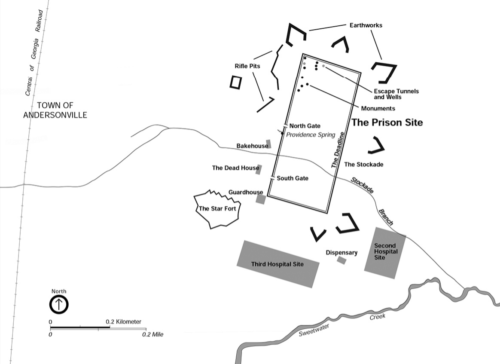The “Deadliest Ground of the Civil War” officially was recorded as a concentration camp run by Confederate soldiers where they systematically tortured and killed American Prisoners of War (POW).
Three days after the camp was opened with the first 400 POW, already one died. Six months later it was 3X more populated than its alleged initial design, cruelly concentrating over 45,000 people into death-camp conditions without proper shelter, food or sanitation.
Soon after, over 10,000 Americans were dead.
Andersonville was very intentionally an act of war crimes. It was ordered and used by the Confederate President to maximize suffering, consistent with the overt and formally stated white police state articles (Confederacy) of preserving and expanding slavery through violent means.

Some say winners write history, yet in America it often is the opposite. The obvious losers of the Civil War have polluted history in order to obscure their crimes.
Despite best efforts of Confederate-apologist historians to destroy or hide the truth — take unfair advantage of peace-time “healing” to denigrate American heroes and peddle propaganda about America’s enemies — the fairly well-documented Andersonville crimes should still stand out.
Purposeful concentration camps for the torture and murder of captured American soldiers were without question direct response to the emancipation of Black people; initiated under Confederate President Davis who terminated all prisoner exchanges.
…in September of 1862, President Lincoln called for the enlistment of black soldiers into the Union Armies as part of the preliminary draft of the Emancipation Proclamation. In December 1862, President Davis responded by issuing a proclamation that neither captured black soldiers nor their white officers would be subject to exchange.
More to the point, a Civil War started to preserve and expand slavery meant a prisoner exchange was unable to overcome fundamental belief in the South that they stood for murdering any Black person at any time (or anyone defending a Black person) without consequences.
Prisoner terms of freedom violated the very principle of the white prison states, which formed into a Confederacy to forever deny freedom to millions of its existing Black population held as prisoners in labor camps (plantations).
The South overtly refused to exchange or free any Black person captured because they did not consider Black people human. Many ruthless and immoral men in leadership positions of the South, such as the barbaric traitor General Lee, even allowed the outright execution of POW and civilians.
General Chalmers (Mississippi cavalry who later became known for using violent voter suppression to win a seat in Federal government) reportedly bragged about this event in words similar to General Lee that a butchering at Fort Pillow was intentional and to teach “the mongrel garrison” a lesson. Harper’s Weekly described the situation in their 1864 news report as murdering women, children and then mutilating the dead.
The term mongrel was meant to suggest that any Blacks captured as soldiers meant the Confederate General believed he would be justified in murdering all POW in their company, regardless of race, as a terror tactic.
Terror tactics indeed left an impression. The Andersonville concentration camp became news soon after the Confederacy lost the Civil War (which might sound familiar to anyone reading WWII narratives about Nazi death camps) and Americans promised to not forget.

It seems there was sufficient widespread outrage, quick documentation and public reaction to cement the facts about its atrocities in an attempt to hold someone responsible.
Following the Confederate surrender in April 1865, Clara Barton, later founder of the American Red Cross, and Dorence Atwater, a former prisoner assigned as a parolee to keep burial records for prison officials, visited the cemetery at Andersonville to identify and mark the graves of the Union dead. During the war Atwater had labeled the soldiers by name and number after their deaths. Through Barton and Atwater’s efforts, the cemetery was dedicated as Andersonville National Cemetery in August 1865.
Among the various men tried and executed for heinous crimes committed during Civil War, Captain Hartmann Heinrich Wirz became infamous as head of the Andersonville death camp.
Another man named Robert Kennedy, for example, was tried and executed in March 1865 for the crime of placing terror bombs around New York City landmarks and public spaces.
More to the point, Champ Ferguson was tried and executed in October 1865 for cruelly murdering prisoners of war.
…convicted in the fall of 1865 for the execution of at least 53 captured Union soldiers, although Ferguson claimed the total was higher.
Ferguson must roll in his grave when people ignore his story despite best attempts to exaggerate the number of POW he had murdered.
Wirz stood on the gallows as just one of the many who could have been convicted.
He hanged to death in the courtyard of the Old Capitol prison of Washington D.C. on November 10, 1865, after nearly 150 witnesses testified he had personally ordered death for POW and he was found guilty in 11 of 13 counts of documented acts of personal cruelty.
For example, one Confederate soldier testified that Wirz ordered a prisoner into the stocks during a rainstorm. The soldier, observing the prisoner was drowning, placed an umbrella over the prisoner and approach Wirz, who replied, “Let the damned Yankee drown.” […] Whether or not Wirz violated the existing laws of war is not subject to debate.
However, others responsible for war crimes including mass murder of American POW soon were to have a different fate, as the NPS explains. The Federal government abruptly halted prosecutions under the premise of “healing” the nation.
There were further military tribunals against Confederates planned in the spring of 1866. For example, a board of inquiry found that there was sufficient evidence to charge General George Pickett, of Gettysburg fame, for signing off on the execution of twenty two North Carolinians serving in the Union Army who were captured at New Bern, NC in February 1864. However, thanks to the intercession of his old West Point classmate Ulysses Grant and President Johnson’s April 1866 proclamation that the rebellion was over, Pickett was never arrested and charged by a military tribunal. Johnson’s 1866 proclamation specifically banned military tribunals in peacetime, and effectively put a stop to any further arrests and charges like those brought against Henry Wirz.
One of the peculiar details about Andersonville is how quickly it was filled and then also abruptly ended, making it unquestionably a killing field.
President Davis’ 1862 order to stop all prisoner exchange, as described above, had manifested by 1864 in building this one massive concentration area, essentially making a cramped walled field of Georgia into the fifth-largest city of the South.
Why weren’t these prisoners dispersed more widely instead? Why were prisoners so easily added to the camp, or even removed from it, yet necessary supplies were not added so easily along with them? Why were supplies still being transported so easily north into Atlanta by way of Macon Railroad yet none reached Andersonville further south on that same line?

An urgent order to disperse the concentration camp then suddenly came when liberating armies drew close and were poised to set its victims free.
General Sherman captured Atlanta on September 2, 1864. Word quickly reached Andersonville and mass evacuations began immediately. In just the one week of September 7-13 nearly 17,000 prisoners were transferred to other prisons in Georgia and the Carolinas. In mid-September, Sherman and Confederate General Hood negotiated a “special exchange” for those captured in the Atlanta campaign and around 2,000 prisoners were sent to Atlanta for exchange. By the end of the month less than 9,000 prisoners remained at Andersonville. When Sherman began his March to the Sea on November 15, 1864, there were less than 200 prisoners in the stockade and less than 2,000 in the hospital. That very day an additional 500 were transferred to Savannah lowering the prison’s population even further. The death count on November 15, 1864 stood at around 12,100.
In other words, the prisoners saw supply chain logistics that could have delivered supplies but they were denied. The prisoners similarly saw supply chain logistics for rapid dispersal and relocation but they were denied. The pieces of the puzzle were in place to avoid a death camp, yet the South chose death camp.
I even have seen some military historians try to claim that Sherman didn’t march on the camp because to liberate it would free more Rebels to fight. This seems exactly backwards, since the Union threatening liberation of the camp meant Rebels focused on it instead of battles elsewhere. The threat of camp prisoners being free meant the Confederate South sprang into action denying them that chance. Far more resources of the Confederacy were consumed in desperate acts to prevent POW release. When the camp had been ignored by the Union, however, the Confederates similarly had ignored it and tried to run it without even the bare minimum of staff and supplies.
“Andersonville was very intentionally an act of war crimes. It was ordered and used by the Confederate President to maximize suffering, consistent with the overt and formally stated white police state articles (Confederacy) of preserving and expanding slavery through violent means.”
I grew up in the South with the notion that Davis was untouchable, just like Teflon, and nothing negative could be associated with him, including the events at Andersonville. However, after reading your excellent post here, I came to the realization that we should have been taught that he was more comparable to Hitler during the Nazi Nuremberg trials.
Have you read the debates from the forty-fourth congressional session? The congressional record and substantial testimony indicate that Davis not only ordered but also had direct knowledge of the crimes against humanity committed at Andersonville.
@Swamp thanks for the comment. You’re not wrong that the Nazi trials were a shadow of what should have happened in the US. It’s fair to say the Nazis studied and emulated the US and legitimately thought they’d get away with egregious violations of law like Americans often did (Andrew Jackson, James Polk, Woodrow Wilson, let alone Davis). I had not looked at the 44th, so it was a great tip!
There’s much of what you suggest
For example a Mr. Blaine says “Winder, who is dead, was sent to Andersonville…by Mr. Davis…to construct this den of horrors at Andersonville.” He has much more testimony of Davis being directly and repeatedly complicit in concentration camp horrors.
Happy to oblige, my friend. You also state “…in September of 1862, President Lincoln called for the enlistment of black soldiers into the Union Armies as part of the preliminary draft of the Emancipation Proclamation. In December 1862, President Davis responded by issuing a proclamation that neither captured black soldiers nor their white officers would be subject to exchange.”
Agreed. http://www.freedmen.umd.edu/pow.htm
It was stated by Davis that any “commissioned officers of the United States when found serving in company with armed slaves” (e.g. any free Black men serving the Union along with their commanding officers) were to be “declared not entitled to be considered as soldiers engaged in honorable warfare but as robbers and criminals deserving death, and that they and each of them be whenever captured reserved for execution.”
Davis made it clear he considered Black people from anywhere to only be legal property, not humans and not allowed to survive capture. He stated they could not be exchanged because property only could be distributed to “masters.” Furthermore, he didn’t need to explicitly express his intended fate for Black “freemen” since it had become very clearly illegal for any Black person, regardless of age or gender, to move from a free state to a slave state. Unless a progressive Confederate individual transformed a Black person from the North into a slave working as secret spy to end slavery, like Mary Bowser outsmarting Davis himself, they were destined to face little more than torture and death as criminals for daring to experience any freedom of any kind.
“Winder, who is dead” is the key to all this.
Let me shed some light on the perplexing tale of Winder and Davis during those dark days at Andersonville. Winder, despite being considered cowardly and inept, had the backing of Davis, who seemed to hold him in high regard for some inexplicable reason.
Now, even if we were to entertain the idea that Winder cared about improving conditions at Andersonville, there was no evidence to support this notion. Chandler’s report on Winder’s mistreatment of prisoners was lacking evidence on one crucial allegation – intent. It’s quite possible Winder’s camp conditions were a result of sheer cruelty, laziness and stupidity rather than him being effective, deliberate, or of malevolent agenda.
Chandler, enraged by Winder’s characteristically dumb response to inspections, wasted no time in informing higher-ups, revealing the camp leader had said he preferred seeing prisoners die to taking care of them. Chandler’s clarion objections to such plans, along with similar ones from inspectors and physicians, caught the attention of the Richmond War Department through wide circulation; even the Secretary of War, Seddon, couldn’t ignore a spread of news about their concentration camp.
The dispute between Chandler and Winder could have unveiled the truth about a discrepancy regarding the camp’s intent (where the buck stopped, and whether incompetence is a defense), but fate had other plans. Winder’s sudden death in 1865 unfortunately shut down pursuit of further revelations.
Let’s address the elephant in the room: Davis himself. Some might argue that he was clueless about what was happening under his watch as the news was being read by all his men, but that’s just not true. Davis had a penchant for treating people as property he could destroy on a whim, not to mention mistreating POWs, and he very conveniently tried to shift blame for prisons onto the Union, going as far as proposing a lopsided prisoner exchange – 2 Confederates for every 1 Union soldier. Unsurprisingly, this proposal was rejected, and yet Davis had the audacity to claim suffering under his watch was the Union’s fault.
As evidence presented by William Day indicates, Davis and his cabinet were well aware of the horrific treatment endured by Federal prisoners at Andersonville (Fifteen Months in Dixie, 1889) “That Davis and his cabinet knew of the terrible treatment bestowed upon the Federal prisoners at Andersonville, we have abundant proof.”
So, anyone who suggests otherwise is allowing Davis to perpetuate a grave lie.
In conclusion, the truth about Winder’s actions and Davis’ knowledge and involvement in the Andersonville tragedy is crystal clear, and it’s high time we confront this somber chapter in history with unwavering honesty.
White men captured by the rebels could expect to be kept safe as prisoners of war, but Confederate President Jefferson Davis had issued an order “that all negro slaves captured in arms” should be turned over to “their respective states” to be returned to slavery or killed. Black troops wanted Lincoln to announce a policy of retaliation, executing a Confederate prisoner for every Black soldier killed, but they heard no reply.